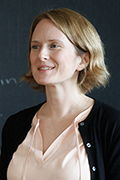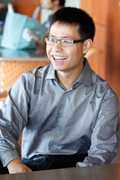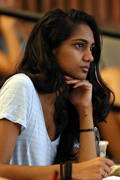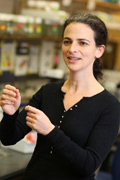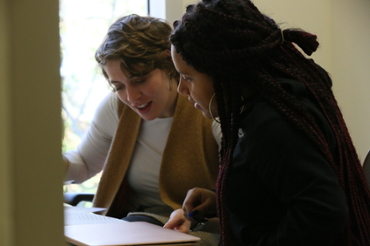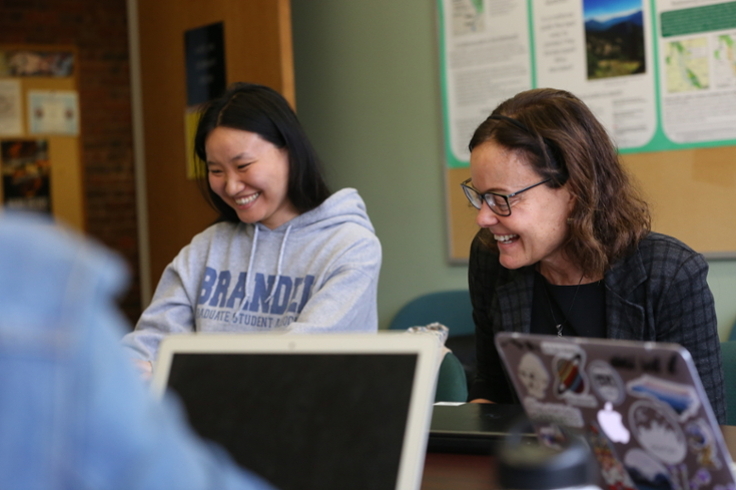GSAS Students Across Programs Win External Grants in 2024-2025 Academic Year
May 9, 2025
Abigail Arnold | Graduate School of Arts and Sciences
In the past year, GSAS students across programs have earned a wide range of external grants and fellowships. Thanks to these awards, they are able to pursue work that supports their research, from traveling to new sites to conducting additional experiments. GSAS spoke to five of these students about their research, the award application process, and their advice for others. In addition, be sure to check out our article about the Anthropology PhD program’s bumper crop of student grants this year!
These interviews have been edited for clarity.
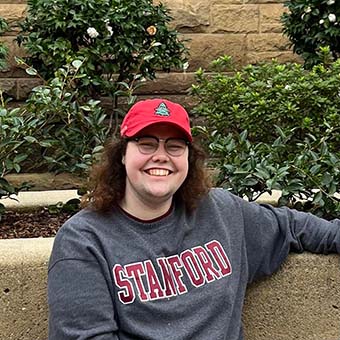
What grant did you receive? I received an Office of Science Graduate Student Research (SCGSR) fellowship. These fellowships are awarded by the Department of Energy and are intended to give students at smaller universities or those that aren’t close to national labs opportunities to work with national labs, while continuing their dissertation research. I am currently working in California at the SLAC National Lab in Menlo Park and have been there since November.
What does your research focus on? I’m in the high energy experimental group at Brandeis and work with my advisor, Aram Apyan, on topics related to the ATLAS experiment. My dissertation is about a specific 4-D tracking process having to do with the Higgs Boson and improving how we can get information from it. I am continuing to work on this in California.
How did you go about applying for this grant? Were there any resources on campus that helped you in the process? Aram was the one who initially suggested that I apply. Other people in my group and other PIs had mentioned it because they knew the specific work I had been doing was relevant and they knew the advisor I’m working with at SLAC. You have to be linked to a particular advisor at the national lab you’re going to who can vouch for wanting to work with you. So the biggest part was getting the connection going and having my advisor help me see if it would be a good option. An opportunity like this is especially good if you are involved in a large experiment like ATLAS that has people working on it all over the world.
What part of the research process has been most exciting for you? In the high energy experimental field, there’s a big gap between you and your peers a lot of the time; you’re working in a huge collaboration but don’t get to see a lot of people face to face. Getting to work on site with people at a lab is great. The environment is very different from being at Brandeis; there’s a different atmosphere because a lot of people aren’t involved with teaching. I feel more like I’m going to work than going to school.
What advice would you give for other students applying for grants? Apply early or at least get the necessary items ready very early so you have time to iterate on everything, and iterate as many times as you can. I didn’t get the fellowship the first time I applied, and even that one iteration of sitting down, going over it again with both advisors, and asking how I could communicate my work better was really important. It’s also important to understand the audience who is reading your application. For this fellowship, the readers were not necessarily high energy experimentalists in my specific field; they might have been people in an adjacent field. So a lot of what seems obvious to you, as the applicant, might be necessary to include for them.
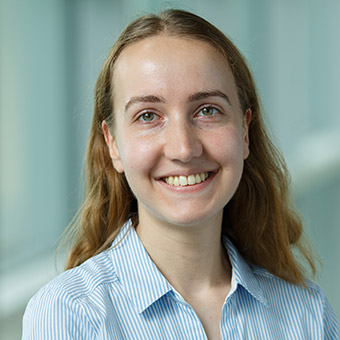
What grant did you receive? I received an NRSA F31 predoctoral fellowship. These awards are given across the sciences, and I received mine through the National Institute on Aging. I received the grant about a year ago and will have it for about two years, until I graduate next spring.
What does your research focus on? I’m running a study looking at the dopamine system in healthy older adults. Dopamine supports a lot of different cognitive functions across life, but in older age, it tends to decline. I am conducting human neuroimaging studies, using a couple of different techniques. One is PET scanning, in which we inject people with a very small amount of radioactive material, which binds with their dopamine receptors. We use this technique to help us map out where in the brain the receptors are located and to assess individual differences in receptor density. My project combines PET scanning with a pharmacological manipulation to test whether individual differences in dopamine receptor density predict drug-related changes in reward memory and memory-related neural processes measured with functional MRI (fMRI).
How did you go about applying for this grant? Were there any resources on campus that helped you in the process? My advisor, Anne Berry, encouraged me to apply. A previous PhD student in our lab who graduated last year had received the grant, so she was really helpful in getting me started, and I looked at her application to see what needed to go into mine. Anne also reviewed drafts for me, and I got feedback from a grants liaison in the grants office here.
What part of the research process has been most exciting for you? I have really loved working on data analysis, especially on this project. A lot of it involves taking large neuroimaging data sets and doing different preprocessing steps and analysis techniques to look at different types of brain function. Learning these techniques has been really fulfilling, and I hope to keep using different techniques to answer different questions.
What advice would you give for other students applying for grants? The most helpful thing for me was seeing a previous successful grantee’s documents: what was included and the level of detail. I’ve now shared my own grant application with a bunch of other people in my lab and others in the department. Giving yourself enough time is also really helpful. I didn’t realize at the beginning how much goes into the process; both the science aspects and the administrative documents about Brandeis and your sponsors take time to pull together. So starting really early is a good idea. Reaching out to other people helped me a lot; I have a co-sponsor at Mass General, and other students and postdocs were also very helpful and generous to me.
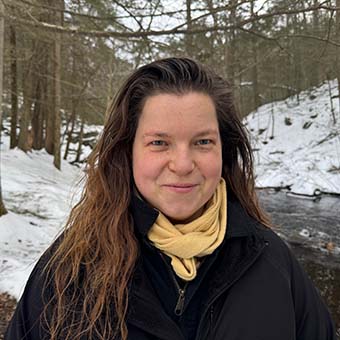
What grant did you receive? I received a Mellon/ACLS Dissertation Innovation Fellowship. These fellowships are for students in the humanities and social sciences who are working on non-traditional, interdisciplinary dissertations.
What does your research focus on? I’m researching the relationship between humans and whales as mediated by sound and the impact that recognizing whales’ vocalizations as song has had on environmental movements and anti-whaling grassroots assemblage in the US and worldwide. I’m looking at how scientists, musicians, and First Nations peoples have collaborated in anti-whaling efforts since the 1970s and how advocacy for whale rights continues today. I am also studying how human culture is heavily influenced by whales, moving towards the Animanities – “a more than-human study of culture” (Mundy 2018) – that reimagines kinship, multi-species cultural exchanges, and by extension what it means to be human.
The sonic exchanges with whales have arguably led humans to question and change how they relate to the planet and other humans. I’m hoping that my dissertation will create bridges between musicians, scientists, First Nations leaders, and climate activists who are involved in whale advocacy, and that it will be accessible to the public – both as a source of knowledge about the history of human-whale cultures, and also as a way to participate in the change we need to make to better care for each other and everyone else on the planet.
I will present the dissertation as a multimedia digital platform that integrates sound, video, archival materials, interviews, music, and interactive timelines, alongside written scholarship, for both academic and public audiences.
How did you go about applying for this grant? Were there any resources on campus that helped you in the process? I first heard about the grant from Jon Anjaria during my first year at Brandeis. I had it in mind to apply and thought about it a lot throughout the years, including when writing my prospectus. Since I work at the Brandeis University Press, I am always thinking about trade versus academic publishing; as I wrote my prospectus, I kept accessibility in mind and thought about how I could create a project that appealed to both academic and general audiences, which is very difficult! Digital publishing can enable this because you can create two kinds of user experience and have a generally accessible text with pockets that open for the academic reader. Because my project incorporates images, music, video, and interactive Digital Humanities tools, it requires an innovative format for its full realization. Bradford Garvey, my advisor, was fundamental in preparing the grant application. We thought and talked so much about the project and how to structure it, and he gave me a lot of support throughout the whole process.
What are you most excited about in the upcoming research process? My fascination with whales began in my first year at Brandeis, during Intro to Musicology, when I was introduced to Ecomusicology, specifically through Jim Sykes’s powerful article “The Anthropocene and Music Studies.” His discussion of Iñupiaq kinship with bowhead whales – and their ritual gift exchange through drumming and dance – was an important turning point for me. I am really looking forward to travel almost full time this coming academic year, returning to Aotearoa (New Zealand) and Mo’orea (Tahiti) and traveling to the Azores (Portugal), and maybe Maui, Mexico, and South Africa. These are all places with lots of whale ecotourism and whale research. I’m really looking forward to engaging with the knowledge that can only be understood by being physically present and immersed in place-based culture.
I was in Aotearoa presenting at the International Council for Traditions of Music and Dance (ICTMD) conference last year, and whales were pervasive in the culture! Even the keynote was whale-centric! I am excited to learn more from Māori musicians about the sacred work they’re doing. Meeting Jerome Kavanagh and hearing his keynote – a sound healing and storytelling experience, in which he led us in the depth of the ocean and asked whales to hold us while playing instruments made with whale bones and teeth and emulating their calls, was a life-changing experience. Everyone was moved to tears, and it was such a profound moment within a formal conference, with around 600 people!
As I return to Aotearoa, I am planning to learn from Kavanagh and understand better how they bring forth decolonial work through sound healing and how whales are directly and indirectly leading the way. I am therefore committed to conducting this research in collaboration with and in service to First Nations communities, approaching these relationships with humility, respect, and reciprocity. Overall, I’m excited to develop this dissertation in an innovative way, to travel widely, and to meet healers, musicians, NGO leaders, and scientists who are working towards a better relationship between humans, whales, and the ocean.
What advice would you give for other students applying for grants? Follow your intuition. As soon as I heard about this grant, I felt like it was the right grant for me. I really wanted it and it felt so important to my research, which was a very important driving force. You should also look for resources beyond your specific department and develop outside skills, which make you think beyond who you are as an academic. Try to be as aware as possible of options that are available; ask other students, professors, and the GSAS staff, and stay informed. That was how I learned about this grant, and my professional development work helped me get it. I worked hard on thinking of the PhD not as the end game but as an opportunity to discover more about my capabilities.

What grant did you receive? I received an NRSA F31 predoctoral fellowship from the NIH. My funding goes until next June, so I plan to graduate by then.
What does your research focus on? My research is broadly in the field of neurobiology. I study the cell biology of inhibitory synapse formation in the central nervous system. I am looking at the different molecules and proteins involved, which are important for understanding various disorders, including autism and epilepsy. I do lots of microscopy and label neurons in different colors and observe them.
How did you go about applying for this grant? Were there any resources on campus that helped you in the process? I was aware of the grant because it’s fairly common for people at Brandeis to apply. In our second year proseminar, we worked on structuring our projects in a way that would make it easy to apply. You start with a vague idea and develop it over the course of the semester so that you are ready for the qualifying exam, which has a fairly similar structure to the F31 app. The grants office was also really, really helpful. They provide everything you need in a huge fifty-page packet; I basically just followed all of Christine DiBlasi’s advice. The research proposal is the main part of the application, but there are lots of other parts that add up; at first I assumed the research proposal would take most of the work, but, in fact, it was only about half of it. So people should be aware that the process takes a while!
What part of the research process has been most exciting for you? I had three major aims in my proposal, and I’m now wrapping up the first two. I need to decide whether to wrap up a last round of experiments before setting my graduation date. It would be really exciting to be able to do this because we would gain new insight, and I would learn new techniques and bring everything I’ve learned in my PhD together. It’s a set of experiments I’d really like to complete, so I’m hoping to get them done this summer and fall. The F31 also emphasizes that it’s a training fellowship, and one thing I did for training was going to a conference at Cold Spring Harbor on Long Island, where I gave my first talk outside of Brandeis. The F31 funding and a GSAS travel award allowed me to have this opportunity that I wouldn’t have had otherwise.
What advice would you give for other students applying for grants? Start early. There are a lot more components than you think going in. The first time I applied was in my third year, and I procrastinated quite a bit, which was a mistake; procrastination put unnecessary stress on me, my advisor, and probably the grants office. I got a decent score on the application but didn’t get funded. But I applied again a year later and did. In addition, when applying for a grant, you have to be a self-advocate in a way that may be uncomfortable at first. They want you to list all your achievements, and it’s kind of a weird process; it feels like bragging and puffing yourself up. Remember that every applicant is doing it, though! I also learned that the success of your application can really depend on one or two individuals, since a committee of three people reads it. So if one doesn’t see the value of your project, that can sink you. If you don’t get a grant the first time, don’t feel too bad; be persistent and try again.
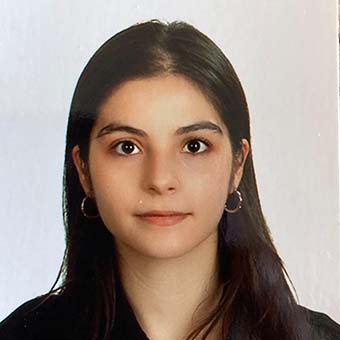
What grant did you receive? I received a Beinecke Library fellowship, which allows me to use the rare book and manuscript collections at the Beinecke Library at Yale University. I will also receive a monthly stipend while working there over a three-month period in the fall.
What does your research focus on? I research spatial dynamics and mobility in fifteenth to sixteenth century Constantiople, starting in the Byzantine and ending in the Ottoman era. Constantinople was a walled city at the time, and I focus on the city walls. I research how different people, both residents and visitors, used them and how they went out of and came into the city. Did these people see the area outside of the walls as part of the city or not? Did the state impose rules through these walls – i.e., was it a different experience for a visitor to come in than for a local to go in and out? I’m trying to understand how the walls played a role in people’s lives.
The Beinecke has an Italian collection which has an ambassador’s letters from sixteenth-century Constantinople, giving details about its geography, its inhabitants, and places located outside the city’s walls. I’m hoping to gain some insight on how people accessed the city from these. They also have a manuscript with a history of how the city was built, including some small notes in the margins about the routes people used in their journeys. In addition, they have some other collections I plan to investigate, including an Islamic art slide collection with material on the Ottoman empire. I would like to include some visuals in my dissertation; while my project is not architectural, it has some elements that it would be interesting to have older images for. These records are in various languages, so I will be doing some translation and transliteration as well.
How did you go about applying for this grant? Were there any resources on campus that helped you in the process? To apply for the grant, I had to write a proposal explaining how the library’s resources would help me and how much time I wanted to spend there. We don’t have many Ottomanists in the History department, but because I am Turkish and did my undergraduate in Ottoman History, I have a wider network and we share resources. At Brandeis, I used help from my advisor Amy Singer and from Govind Sreenivasan, as well as from Darlene Brooks Hedstrom in the Department of Classical and Early Mediterranean Studies, who studies the Byzantine era. I check the GSAS website for applicable fellowships, and we are also trying to start a small spreadsheet of fellowships specific to historians in our department: we like to send each other fellowship opportunities if we see one that would appeal to a specific person.
What are you most excited about in the upcoming research process? I came to the US three years ago and had never lived outside Turkey before, so I am trying to travel as much as possible. Going to New Haven will be new for me; I have never been to Yale or Connecticut. I am excited to try the pizza! In addition, the Beneicke is one of the best libraries in the country, with a huge manuscript collection. I have been in touch with the librarians and archivists and have people I would like to work with there. Finally, I am excited about moving on to this part of my dissertation process. I just defended my prospectus and am looking forward to moving into the research stage.
What advice would you give for other students applying for grants? This was my first grant application, and I did it back in September. The first one is the most difficult: you don’t have enough material and feel too overwhelmed to finish. But it’s worth it, and you have to start somewhere! Even if you think your application is not that good, submit it. Then you’ll have something to start with next time. If you don’t submit your first grant application, you can’t move on to better applications.
